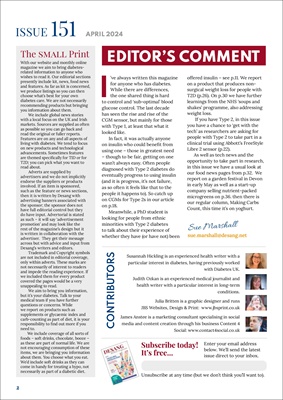
2
ISSUE 151 If you read through this issue you
will see that there is a theme
that recurs. The magazine has
always been written for anyone
living with diabetes, though with an
emphasis on 'kit', or what now gets
called 'med-tech'.
The last decade brought insulin
pumps and CGMs to the fore,
slowly but surely, with a focus on
Type 1 diabetes, which was a very
specifically defined group, that being
the unique challenges brought on by
having insulin 'on the outside, not the
inside.'
Type 2 diabetes is not about
the absence of insulin, but an
insufficiency (not enough of it) and
inefficiency (not able to work as well
as it should. But high or mismanaged,
uncontrolled blood glucose in any
person is a problem, and a challenge.
In order to improve the health
outcomes of the many people
diagnosed with Type 2 diabetes,
existing technologies are being
EDITOR'S COMMENT
repurposed, or redirected at this
condition. So the theme in this issue
is about CGM to help treat T2D.
A second theme is that of 'having
your say'. Can you voice predict your
chances of developing T2D. Take
part in a survey to help find out). Or,
take another survey to help shape
the future of where T1D research
ought to head. Plus, our lead feature
and cover story is about PROs - in
this case, not 'professionals' as such,
but Patient Reported Outcomes
(PROs). It's really about improving
communication skills between
patients and HCPs to get the best for
both parties.
Due to the timing of this issue,
we've got an extra helping of food
info in time for Easter. And in our
Making Carbs Count section we
check out that very smelly but
marvellous bulb, garlic.
sue.marshall@desang.net
Sue Marshall
Enter your email address
below. We'll send the latest
issue direct to your inbox.
Unsubscribe at any time (but we don't think you'll want to).
APRIL 2024
The small Print
With our website and monthly online
magazine we aim to bring diabetesrelated
information to anyone who
wishes to read it. Our editorial sections
presently include kit, news, food news
and features. As far as kit is concerned,
we produce listings so you can then
choose what's best for your own
diabetes care. We are not necessarily
recommending products but bringing
you information about them.
We include global news stories
with a local focus on the UK and Irish
markets. Sources are supplied as often
as possible so you can go back and
read the original or fuller reports.
Features are on any and all aspects of
living with diabetes. We tend to focus
on new products and technological
advancements. Sometimes features
are themed specifically for T1D or for
T2D; you can pick what you want to
read about.
Adverts are supplied by
advertisers and we do not implicitly
endorse the suppliers or products
involved. If an item is sponsored,
such as the feature or news sections,
then it is written by Desang with
advertising banners associated with
the sponsor; the sponsor does not
have full editorial control but they
do have input. Advertorial is stated
as such - it will say 'advertisement
promotion' and may look like the
rest of the magazine's design but it
is written in collaboration with the
advertiser. They get their message
across but with advice and input from
Desang's writers and editors.
Trademark and Copyright symbols
are not included in editorial coverage,
only within adverts. These marks are
not necessarily of interest to readers
and impede the reading experience. If
we included them for every product
covered the pages would be a very
unappealing to read.
We aim to bring you information,
but it's your diabetes. Talk to your
medical team if you have further
questions or concerns. While
we report on products such as
supplements or glycaemic index and
carb-counting as part of diet, it is your
responsibility to find out more if you
need to.
We include coverage of all sorts of
foods - soft drinks, chocolate, booze -
as these are part of normal life. We are
not encouraging consumption of these
items, we are bringing you information
about them. You choose what you eat.
We'd include soft drinks as they can
come in handy for treating a hypo, not
necessarily as part of a diabetic diet.
Susannah Hickling is an experienced health writer with a
particular interest in diabetes, having previously worked
with Diabetes UK.
Judith Ozkan is an experienced medical journalist and
health writer with a particular interest in long-term
conditions.
Julia Britten is a graphic designer and runs
JBS Websites, Design & Print: www.jbsprint.co.uk
James Anstee is a marketing consultant specialising in social
media and content creation through his business Content 4
Social: www.contact4social.co.uk